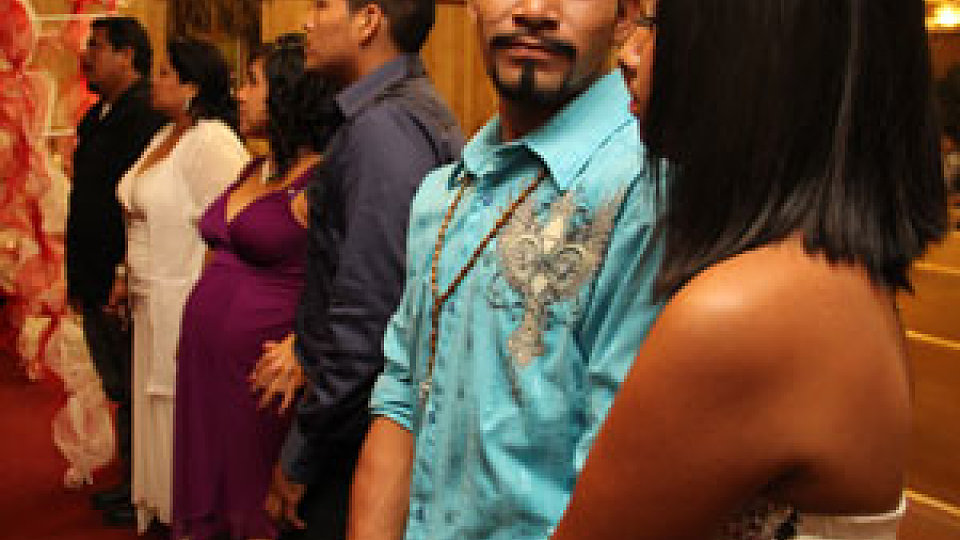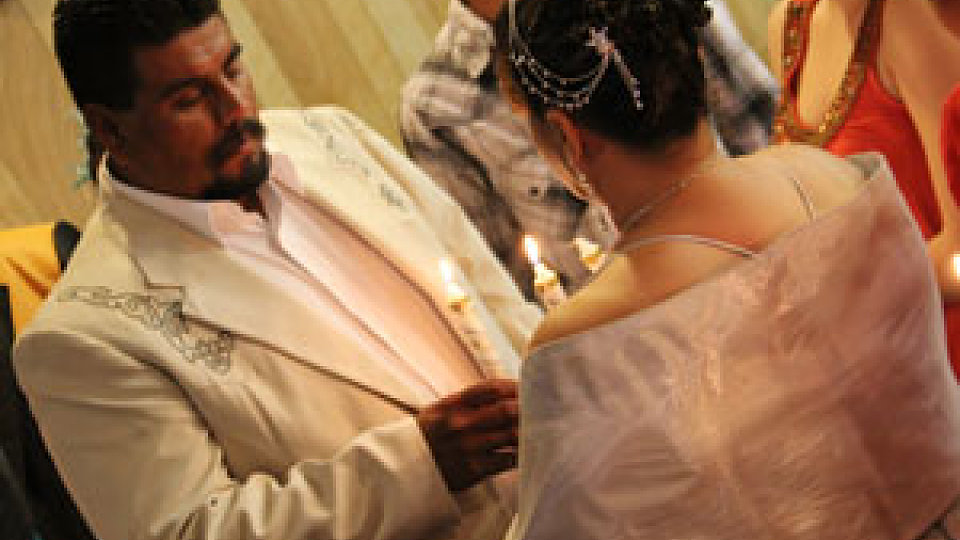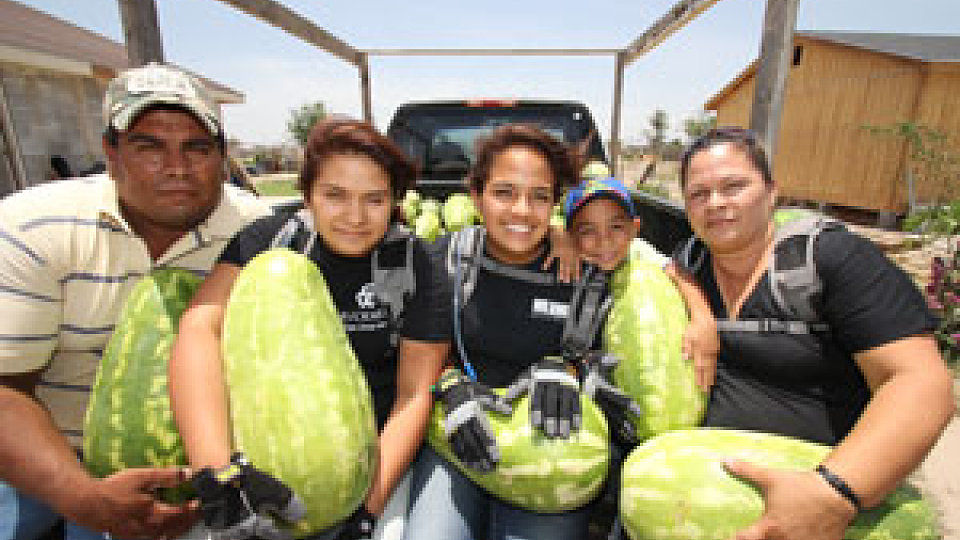Tying a Strong Knot of Hope
By Lauren Hollon Sturdy
Buckner International
Seven brides take turns posing one at a time beneath a red and white ribbon-bedecked arch at the end of the sanctuary’s center aisle. One of the husbands-to-be snaps photos with his tablet next to the wedding photographer. You can see some of the pre-wedding jitters begin to melt away as the women laugh and loosen up during portraits.
A storm rolls in and the air smells like rain. One of the brides, late to her own wedding, nearly gets caught in the downpour. Her hair is slightly dampened, but her spirits are not; she’s looked forward to this day for a long time.
This wedding is in no way typical. There are seven couples of all ages and all different stories, all waiting to be married on the same night. The youngest bride is 16 and eight months pregnant. The oldest is in her mid-40s.
These diverse families have been brought together by their connection to the Buckner Family Hope Center in Peñitas, Texas. They have all reached a point of newfound confidence in their lives and relationships – a confidence that’s allowing them to finally tie the knot.
“One of the things I’m so excited about today is that I see the hope in these families,” says Ricardo Brambila, director of the Family Hope Center and officiant for tonight’s ceremony. “Their children are so excited because they’re going to see mom and dad getting married. It began with the conversation we give them in the family strengthening class – how are you going to tell your kids to get married someday if you’re not married?”
All seven couples are in case coordination at the Hope Center, Brambila says, and all have been together for anywhere from three to 12 years.
“For them, the Hispanic culture is that they think, ‘We might not make it,’” Brambila says. “They don’t want to commit because they don’t know if they’re going to make it, because first they need to meet their needs. But once their basic needs are met and they’re stronger as a family, they
begin thinking about morals. It’s like a threshold. Once your basic needs are met, you begin to think through the future.”
While Brambila briefs the couples on the order of service, family and friends visit and find seats. Little boys in clean, pressed button-down shirts and slick, combed hair sink into the pews with bored looks on their faces. Girls in sequined dresses and bows giggle as they run through the church in small packs.
Four couples have opted for a religious ceremony and three chose a civil ceremony. The stormy weather has Judge Jesse Contreras, officiant for the civil ceremony, running late, but the religious ceremony is scheduled to start first, anyway.
Brambila opens with a greeting and prayer and gives the stage to Pastor Fidencio Vasquez of Primera Iglesia Bautista La Joya, who gives a brief sermon about the gravity of the vows the couples are about to make.
“Marriage isn’t for a week,” he says. “Marriage isn’t for a month. Marriage isn’t for a year. When bad things happen in life, you must take advantage of the opportunity to learn and to form stronger relationships in marriage.”
Ten minutes in, the youngest children lose interest and are shushed by Brambila several times throughout the service. Older kids are milling around, taking photos of their parents’ big moment.
The wedding incorporates traditional Hispanic rites rich in symbolism and culture.
Brambila leads the couples through the lighting of unity candles to symbolize their oneness. Next, the godparents of the lazo (literally "loop" or wedding cord) drape a figure-eight shaped rope over the shoulders of each bride and groom, symbolizing the union and love of the couple with each other and with God.
The godparents of the arras (a set of 13 gold coins) give each groom a clinking handful of coins. The groom pours these coins into his bride's cupped hands, symbolizing his role as provider and reassuring his bride that she will never lack anything. Buckner serves as the godparent of Bibles. Each couple receives a copy, and Brambila exhorts the couples to read the Word of God, live it and practice it each day.
Adults, teens and children crowd the stage with cameras, phones and tablets when its’ time for exchanging rings and vows. The children are visibly thrilled to see and hear their parents pledge to stay together “for better or worse, for richer or poorer, in sickness and in health, to love and to cherish until death” parts them.
With a final prayer, Brambila declares each couple “man and wife.”
Judge Contreras takes the stage to perform the nonreligious ceremony for the remaining three couples, but his faith compels him to give a mini-sermon anyway. He talks about how spousal abuse is a problem in the community and tells the men to mimic “the greatest love story ever told” – God’s sacrifice of His only Son. He admonishes the grooms to follow the example of Christ in how they treat their wives: to respect them, love them and sacrifice themselves for their families.
***
Myrthala Arjona and Julio Cesar Rodríguez Mendoza are one of older couples of the group, and like many of the other couples, their children spurred them to get married.
Paula and Paola are twin sisters from Myrthala’s previous relationship. The 15-year-olds have been a part of the Family Hope Center’s Youth Leaders Program, and Myrthala says she’s seen a change in her daughters because of it.
“Since joining the Youth Leaders, my daughters have become more helpful to others and concerned about other people and less self-centered,” she says. “I’m happy because my kids are always safe there and looked after. I have peace of mind knowing they’re in a safe place.”
The Youth Leaders Program has become part of the Rio Grande Valley Teen Pregnancy Prevention Coalition and has a strong abstinence program, Brambila says.
“We’re talking to them about marriage, talking to them about staying pure,” Brambila says. “So we’re telling the kids these things, and when they go home, the kids say, ‘Hey, they talk about marriage – why haven’t you two been married?’ So when a 14-year-old kid is asking his parents, ‘Why haven’t you two gotten married?’ it starts conversations.”
Myrthala and Julio Cesar have been together for eight years. They have a great relationship built on good communication and a willingness to keep the past in the past.
“He won my children’s hearts first and then won mine,” she says.
“She attends me and uses her serving actions to show that she loves me,” he says. “We are both very united in everything.”
They had planned to get married for years, but never managed to take the leap. It took the twins’ insisting that their parents get married so the family would have God’s blessing. And it worked.
Myrthala looked beautiful on her wedding day in a floor-length silvery-white dress with elaborate embroidery. She found it at the local flea market for just $3.
“We didn’t have the money to buy something very expensive,” she explains. Julio Cesar wore a white suite with coordinating embroidery on the shoulders. They were a perfect pair.
The family has found support from the Family Hope Center in other small, but significant, ways.
The couple works together picking crops; the girls help out in the summer months. Besides being backbreaking labor (especially in watermelon season), the heat is scorching and the vines rough up their hands. Buckner staff gave each member four sets of work gloves for protection and four hydration packs so they don’t have to travel the usual half-mile to the water truck.
“When Becci [Ruiz, Buckner case manager] came with the gloves and backpacks, we were thankful and happy,” Myrthala says. “It’s a small thing, but it makes such a big difference. We’re thankful Buckner is here and thankful they’re concerned about our family.”
Myrthala recently began taking computer classes at the center when she’s not working. She says her children’s schools are switching to digital report cards soon, and the only thing she knows about using a computer is how to turn it on. She says she also wants to be able to monitor what the kids are doing online, and the Hope Center is the only place nearby that offers free classes.
The family has also received financial assistance from the Hope Center at times, and through the Youth Leaders Program, the girls attend church and come home sharing what they’ve learned with their parents.
“What we do at the Hope Center involves a lot of stuff about God,” Paola says. “It’s a good influence. Before I started becoming a part of the Youth Leaders, I didn’t go to church. I would be misbehaving or talking back. Now, I’m more calm.”
Brambila said that the Family Hope Center seeks to minister to each family member “because it’s not enough to only speak to the needs of the parents or children. For true transformation to occur, we must minister to the needs of all.”










Comments